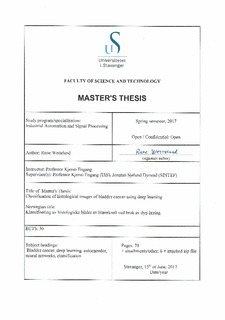| dc.description.abstract | In Norway bladder cancer is the fourth most common cancer type among men, with an almost 70 % increase in incidence the past four decades. For women, the increase has been about 40 %.
The histological images of bladder cancer are investigated by a pathologist to determine the grade and stage of cancer. In addition, the risk of recurrence and progression are also diagnosed. This is done manually by studying the histological images, but reproducibility of these results are low. To aid the pathologist, a proposed automatic system have been designed in this thesis consisting of six steps. Step one to four have been studied and experimented in detail, and step five and six are considered as future work.
The histological images are divided into smaller tiles, where each tile consists of one of several different categories; cancer tissue, damaged tissue, other tissue, blood or background. The aim is to make a system which automatically separates all tiles containing cancer tissue from the rest, as these have the potential to diagnose the cancer grade, stage, recurrence and progression.
To distinguish the different categories from each other, a classification system was constructed consisting of an autoencoder and a classifier trained in a semi-supervised fashion. The autoencoder was trained on 943,127 unlabeled tiles, extracted from seven histological images. Next, the encoder part of the autoencoder was connected to the classifier which was fine-tuned on 152,312 labeled images.
For evaluating the performance of the classifier, 10-fold cross-validation was calculated. Accuracy of the best classifier on a five class dataset was 97.7 % with a standard deviation of 3.2 %. | nb_NO |

